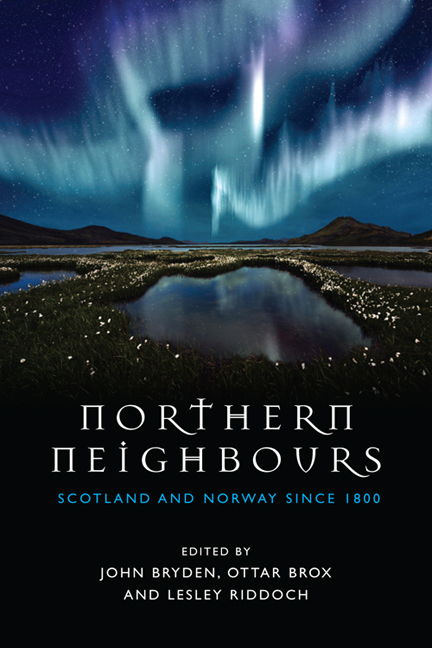Book contents
- Frontmatter
- Contents
- Acknowledgements
- Foreword
- 1 Introduction
- 2 Towards a Theory of Divergent Development
- 3 Cousins Divided? Development in and of Political Institutions in Scotland and Norway since 1814
- 4 Agrarian Change in Scotland and Norway: Agricultural Production, Structures, Politics and Policies since 1800
- 5 The Evolution of Local Government and Governance in Scotland and Norway
- 6 The Development of Industry and North Sea Oil in Scotland and Norway
- 7 Reflections on the Making of Norway
- 8 Money and Banking in Scotland and Norway
- 9 Religion in Scotland and Norway
- 10 The Nordic Welfare Model in Norway and Scotland
- 11 Access, Nature, Culture and the Great Outdoors – Norway and Scotland
- 12 Education in Norway and Scotland: Developing and Re-forming the Systems
- 13 Norway and the United Kingdom/Scotland after the Second World War
- 14 Conclusions
- The Contributors
- Bibliography
- Index
4 - Agrarian Change in Scotland and Norway: Agricultural Production, Structures, Politics and Policies since 1800
Published online by Cambridge University Press: 05 August 2016
- Frontmatter
- Contents
- Acknowledgements
- Foreword
- 1 Introduction
- 2 Towards a Theory of Divergent Development
- 3 Cousins Divided? Development in and of Political Institutions in Scotland and Norway since 1814
- 4 Agrarian Change in Scotland and Norway: Agricultural Production, Structures, Politics and Policies since 1800
- 5 The Evolution of Local Government and Governance in Scotland and Norway
- 6 The Development of Industry and North Sea Oil in Scotland and Norway
- 7 Reflections on the Making of Norway
- 8 Money and Banking in Scotland and Norway
- 9 Religion in Scotland and Norway
- 10 The Nordic Welfare Model in Norway and Scotland
- 11 Access, Nature, Culture and the Great Outdoors – Norway and Scotland
- 12 Education in Norway and Scotland: Developing and Re-forming the Systems
- 13 Norway and the United Kingdom/Scotland after the Second World War
- 14 Conclusions
- The Contributors
- Bibliography
- Index
Summary
INTRODUCTION
The contrasting evolution of landownership in Scotland and Norway is discussed in Chapter 1, as it affects so many social, economic, political and other processes between the Reformation and the present day. One of these concerns agriculture, especially changing agricultural structures, agrarian politics and policies, and rural settlement.
This chapter focuses on four main processes that we consider to have underpinned the important differences in the structure and nature of agriculture and rural settlement and indeed in policies between the two countries today. These four processes are firstly, the timing and nature of the ‘first’ agrarian revolution which to a large extent followed the reorganisation of land ownership and rights and was a much earlier and more powerful movement, and, significantly, driven by different hegemonic ideas about ‘improvement’, in Scotland than in Norway. Secondly, the free trade period and wartime food shortages in the second half of the nineteenth and early twentieth centuries. Thirdly, the development of agricultural policies and extensive State intervention in the inter-war period and immediately after the Second World War. Finally, the ‘second’ agrarian revolution, mainly after the Second World War, involving large-scale mechanisation and the application of artificial fertilisers and chemicals, and new plant- and animal-breeding methods and objectives, and its subsequent consequences and policy responses after the implications of this form of agriculture became clear.
Before moving on to discuss these themes in greater depth, we present some comparative data that illustrates some of the differences between agricultural structure, production, incomes and their evolution over the past two centuries or so.
In terms of land area and its utilisation, Norway is roughly four times larger than Scotland, but has a lower proportion of land used for agriculture and more than twice the proportion of land in forests and woodland. Farming in Norway extends well north of the Arctic Circle, especially near the coast which benefits from the Gulf Stream. However, average temperatures are lower.
Although commodities grown are similar in Norway and Scotland, Norway has a higher proportion of oats in cereals grown, and a lower proportion of barley. The proportion of wheat is almost the same.
- Type
- Chapter
- Information
- Northern NeighboursScotland and Norway since 1800, pp. 63 - 91Publisher: Edinburgh University PressPrint publication year: 2015



